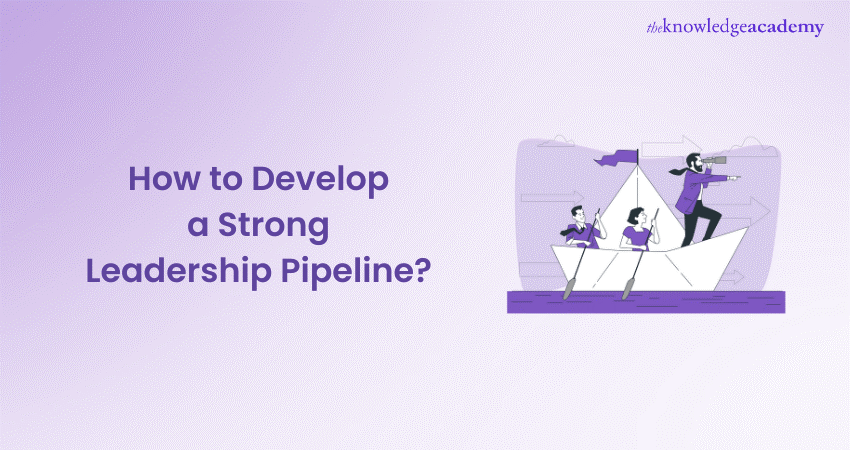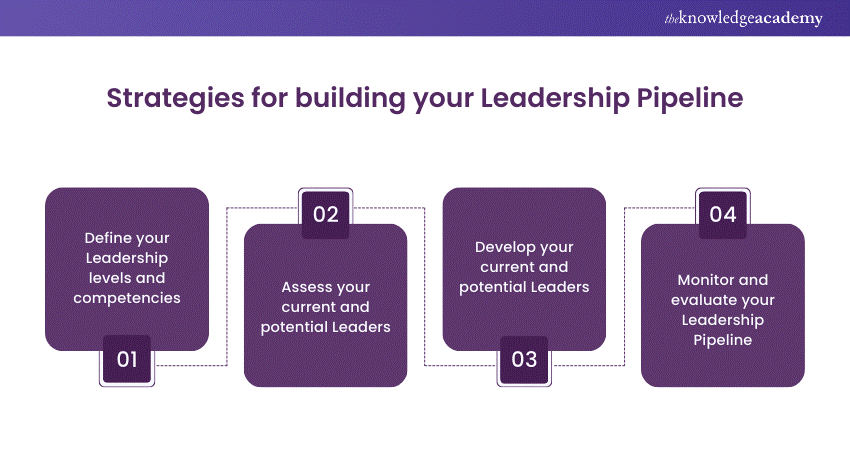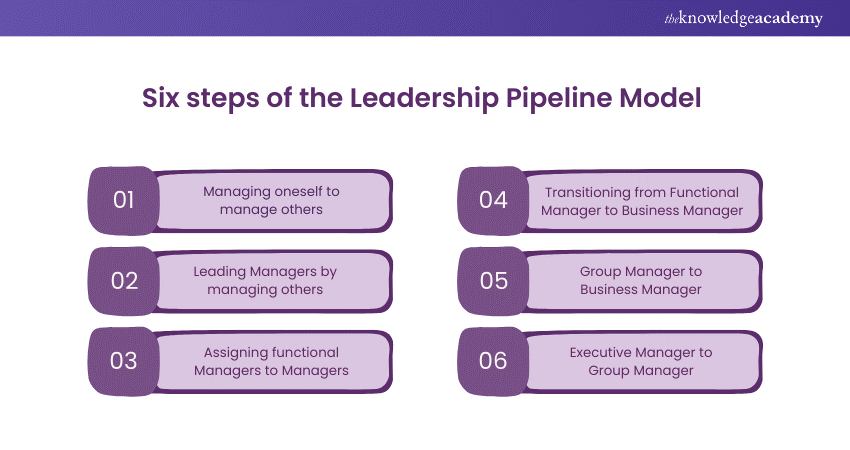We may not have the course you’re looking for. If you enquire or give us a call on 01344203999 and speak to our training experts, we may still be able to help with your training requirements.
Training Outcomes Within Your Budget!
We ensure quality, budget-alignment, and timely delivery by our expert instructors.

Leadership is one of the most critical factors for the success of any organisation. However, many organisations struggle to find and retain qualified Leaders who can drive performance, innovation, and growth. This is where a Leadership Pipeline comes in. A Leadership Pipeline systematically identifies, develops, and promotes Leaders from within your organisation. It ensures a steady supply of talented and capable Leaders ready to take on new challenges and opportunities.
Table of Contents
1) What is a Leadership Pipeline?
2) Reasons for building your Leadership Pipeline
3) Strategies for building your Leadership Pipeline
4) The six steps of the Leadership Pipeline Model
5) Conclusion
What is a Leadership Pipeline?
A Leadership Pipeline is a framework that defines your organisation's different levels of Leadership and the skills, competencies, and behaviours required for each level. It also outlines the transitions Leaders need as they move from one level to another and the support and development they need. A Leadership Pipeline helps you with the following:
a) Align your Leadership development with your business strategy and goals
b) Assess and develop your current and potential Leaders based on objective criteria
c) Create a clear and consistent career path for your Leaders
d) Foster a culture of Leadership and accountability in your organisation
e) Reduce the risk of Leadership gaps and succession issues
Reasons for building your Leadership Pipeline
Building a Leadership Pipeline is a good practice and a necessity for your organisation. Here are some of the benefits of having a strong Leadership Pipeline:
1) It improves your organisational performance and results. Effective Leaders at every level of your organisation can boost productivity, quality, customer satisfaction, innovation, and profitability.
2) It enhances your competitive advantage and sustainability. Having a pool of ready and qualified Leaders can help you respond effectively and quickly to changing market conditions, customer needs, and industry trends.
3) It increases your employee engagement and retention. A clear and transparent Leadership Pipeline can motivate your employees to perform better, grow their skills, and pursue their career aspirations. It can also reduce turnover and recruitment costs by retaining top talent and attracting new talent.
4) It strengthens your organisational culture and values. A consistent and coherent Leadership Pipeline can reinforce your organisational vision, mission, and values. It can also foster a culture of trust, collaboration, and learning among your Leaders and employees.
Transform your Leadership approach and drive success in Agile environments with our Agile Leadership Training. Join today!
Strategies for building your Leadership Pipeline
Building a Leadership Pipeline is not a one-time event but a continuous and dynamic process. It requires a strategic approach that involves multiple stakeholders and activities. Here are some of the key strategies for building your Leadership Pipeline:

Define your Leadership levels and competencies
The first step is to identify your organisation's different levels of Leadership and the core competencies and behaviours expected for each level. You can use a competency model or a framework, such as the Leadership Pipeline Model (which we will discuss in the next section), to guide you in this process.
You should also align your Leadership levels and competencies with your organisational strategy and goals and review them regularly to ensure they are updated and relevant.
Assess your current and potential Leaders
The next step is to evaluate your current and potential Leaders based on the defined Leadership levels and competencies. You can use various tools and methods, such as performance reviews, 360-degree feedback, psychometric tests, interviews, and simulations to assess your Leaders.
You should also consider their potential, readiness, and aspiration for future Leadership roles. This step aims to identify your Leadership strengths and gaps and create a talent pool of high-potential Leaders for succession planning.
Develop your current and potential Leaders
The third step is to design and implement a comprehensive and customised Leadership development program for your current and potential Leaders. You should use a blended approach that combines formal training, coaching, mentoring, feedback, and action learning.
You should also provide your Leaders with challenging and diverse assignments, projects, and roles that can stretch their skills and prepare them for the next Leadership level. This step aims to enhance your Leaders’ capabilities and performance and accelerate their career progression.
Monitor and evaluate your Leadership Pipeline
The last step is to track and measure the effectiveness and impact of your Leadership Pipeline. To evaluate your Leadership Pipeline, you should use quantitative and qualitative indicators such as retention rates, promotion rates, performance outcomes, employee satisfaction, and customer feedback.
Further, you should also solicit feedback from your Leaders, employees, customers, and other stakeholders to identify the best practices and areas for improvement. This step aims to ensure that your Leadership Pipeline delivers the desired results and outcomes and make adjustments and improvements as needed.
Enhance your Leadership skills and become a more effective Leader with our specialised Leadership Skills Course. Register now!
The six steps of the Leadership Pipeline Model
The Leadership Pipeline Model is one of the foremost and extensively applied frameworks for establishing a Leadership Pipeline. This model was crafted by Ram Charan, Stephen Drotter, and James Noel and was introduced in their book titled "The Leadership Pipeline: How to Build the Leadership Powered Company." The model describes six levels of Leadership, each with its skills, time applications, and work values.
It also explains the transitions that Leaders need to make as they move from one level to another and the challenges and pitfalls they may face. Here is a brief overview of the six steps of the Leadership Pipeline Model:

Step 1: Managing oneself to manage others
The first step is transitioning from an individual contributor to a first-time Manager. It is one of the most challenging and critical transitions in the Leadership Pipeline, as it requires a fundamental shift in mindset and behaviour. Here is the list of tasks that Leaders need to follow:
a) Stop doing the work and start managing the work:
A Leader must delegate tasks, set goals, monitor progress, provide feedback, and solve problems. A Leader must also balance the competing demands of managing up, down, and across the organisation.
b) Develop and motivate others:
A Leader needs to coach, mentor, and empower their direct reports. A Leader must also create a positive and productive team culture and recognise and reward performance and potential.
c) Manage oneself:
A Leader needs to manage their own time, energy, emotions, and stress. A Leader must also learn new skills, seek feedback, and adapt to change.
Step 2: Leading Managers by managing others
The second step is transitioning from a first-time Manager to a Manager of Managers. It is another challenging and important transition in the Leadership Pipeline, requiring a further shift in focus and perspective. Here is the list of tasks that Leaders need to follow:
a) Manage Managers and not workers:
A Leader needs to delegate authority, not just tasks. A Leader must also coach, mentor, and develop their Managers and hold them accountable for results.
b) Think and act strategically:
A Leader must align their team’s goals and activities with the organisational strategy and vision. A Leader must also anticipate and respond to market trends, customer needs, and competitive threats.
c) Collaborate and influence:
A Leader must maintain good relationships with peers, senior Leaders, and external stakeholders. A Leader must also communicate effectively, negotiate skillfully, and constructively resolve conflicts.
Step 3: Assigning functional Managers to Managers
The third step is transitioning from a Manager of Managers to a functional Manager. It is a significant and complex transition in the Leadership Pipeline, requiring a deep understanding and mastery of a specific function or domain. A Leader needs to perform the following functions:
a) Lead a function and not a team:
A Leader needs to oversee and optimise the performance and processes of a function or department, such as marketing, finance, or operations. A Leader also needs to ensure the quality and consistency of the products or services delivered by the function.
b) Drive functional excellence and innovation:
A Leader needs to develop and implement the function's best practices, standards, and policies. A Leader must also foster a culture of continuous improvement, learning, and innovation within the function.
c) Align and integrate the function with the organisation:
A Leader must align the function’s goals and activities with the organisation's strategy and goals. A Leader must also collaborate and coordinate with other functions and departments to balance functional and organisational interests and priorities.
Step 4: Transitioning from Functional Manager to Business Manager
The fourth step is transitioning from a Functional Manager to a Business Manager. It is a major and demanding transition in the Leadership Pipeline, requiring a broad and holistic view of the business and the market. Here is the list of tasks that Leaders need to follow:
a) Lead a business and not a function:
A Leader must manage and grow a business unit, division, or region, with full responsibility for the revenue, profit, and loss. A Leader also needs to oversee and integrate all the functions and processes within the business.
b) Develop and execute a business strategy:
A Leader must define and communicate a clear and compelling vision, mission, and value proposition for the business. A Leader must also formulate and implement a business plan, budget, roadmap and monitor and measure the business performance and results.
c) Build and leverage a business network:
A Leader must develop relationships with customers, partners, suppliers, regulators, and other external stakeholders. A Leader also needs to identify and capitalise on new opportunities, markets, and channels for the business.
Step 5: Group Manager to Business Manager
The fifth step is transitioning from a Business Manager to a Group Manager. It is a rare and challenging transition in the Leadership Pipeline, as it requires high Leadership maturity and agility. Here is the list of tasks that Leaders need to follow:
a) Lead multiple businesses and not just one:
A Leader needs to manage and oversee a portfolio of businesses, each with its strategy, goals, and challenges. A Leader must also allocate and optimise business resources, capital, and talent.
b) Create and shape the future of the organisation:
A Leader must envision and articulate the organisation's long-term and inspiring direction and purpose. A Leader must also drive and support innovation, transformation, and growth initiatives within and across the businesses.
c) Develop and nurture the next generation of Leaders:
A Leader needs to identify, develop, and promote the high-potential Leaders who can succeed them and lead the organisation in the future. A Leader must also create and sustain a Leadership excellence and accountability culture.
Step 6: Executive Manager to Group Manager
The sixth and final step is transitioning from a Group Manager to an Executive Manager. It is the most difficult transition in the Leadership Pipeline, requiring supreme Leadership wisdom and influence. Here is the list of tasks that Leaders need to follow:
a) Lead the organisation and not just the businesses:
A Leader needs to set and embody the organisation's vision, values, mission, and culture. A Leader must also ensure the alignment and integration of the organisation’s strategy, structure, systems, and processes.
b) Represent and advance the organisation in the external environment:
A Leader must influence key stakeholders such as shareholders, board members, regulators, media, and society. A Leader also needs to protect and enhance the organisation's reputation, brand, and social responsibility.
c) Balance the present and the future of the organisation:
A Leader must deliver short-term and long-term results and outcomes for the organisation. A Leader also needs to anticipate and prepare for the opportunities and challenges that may arise in the future.
Unlock your Leadership potential and elevate your career with our comprehensive Leadership Courses.
Conclusion
A Leadership Pipeline is vital for building and sustaining a high-performance organisation. It helps you to identify, develop, and promote your current and future Leaders at every level of your organisation. It also helps you create a clear and consistent career path for your Leaders and foster a culture of Leadership and accountability in your organisation. By following the six steps of the Leadership Pipeline Model, you can build a strong and effective Leadership Pipeline for your organisation.
Frequently Asked Questions

A Leadership Pipeline is a structured framework designed to recognise, nurture, and equip high-potential employees for forthcoming Leadership positions. It helps organisations achieve their strategic goals, foster a culture of excellence, and ensure a smooth succession of key positions.

The five elements of a strong Leadership Pipeline are:
1) Opportunities for development
2) Identification of linchpin positions
3) Transparency of the system
4) Regular measurement of progress
5) Flexibility and adaptability

The Knowledge Academy takes global learning to new heights, offering over 30,000 online courses across 490+ locations in 220 countries. This expansive reach ensures accessibility and convenience for learners worldwide.
Alongside our diverse Online Course Catalogue, encompassing 17 major categories, we go the extra mile by providing a plethora of free educational Online Resources like News updates, Blogs, videos, webinars, and interview questions. Tailoring learning experiences further, professionals can maximise value with customisable Course Bundles of TKA.

The Knowledge Academy’s Knowledge Pass, a prepaid voucher, adds another layer of flexibility, allowing course bookings over a 12-month period. Join us on a journey where education knows no bounds.

The Knowledge Academy offers various Leadership Courses, including Leadership Skills and Agile Leadership Trainings. These courses cater to different skill levels, providing comprehensive insights into Organisational Leadership.
Our Business Skills blogs cover a range of topics related to Leadership skills and upskilling, offering valuable resources, best practices, and industry insights. Whether you are a beginner or looking to advance your Leadership skills, The Knowledge Academy's diverse courses and informative blogs have you covered.
Upcoming Business Skills Resources Batches & Dates
Date
 Leadership Skills Training
Leadership Skills Training
Fri 31st May 2024
Fri 28th Jun 2024
Fri 26th Jul 2024
Fri 30th Aug 2024
Fri 27th Sep 2024
Fri 25th Oct 2024
Fri 29th Nov 2024
Fri 27th Dec 2024







 Top Rated Course
Top Rated Course



 If you wish to make any changes to your course, please
If you wish to make any changes to your course, please


